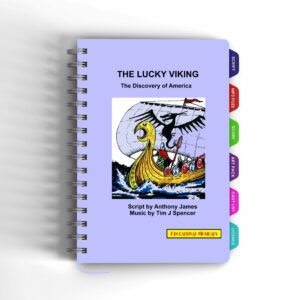
For 300 years, from the 8th to the 11th centuries, the Vikings struck terror into the hearts of their enemies and victims.
Christian monasteries and churches were their favourite targets as they had rich ornaments and gold.
In fact, many of the accounts of their attacks come from monks and priests. For example, a raid on the monastery on the holy island of Lindisfarne in A.D. 793 was described by Alcuin of York, an English priest and teacher as “Never before has such a terror come to Britain as this that we have suffered from a pagan race”.
Even though they have been popularised as brutal raiders crossing the seas in their longships in search of new lands, gold and slaves, they were also successful traders and explorers. Their journeys took them from their homes in Denmark, Norway and Sweden to faraway lands such as Britain, Ireland, France, Spain, North Africa, Italy and Russia.
They even went further, even settling in Iceland and Greenland.
 We have published a musical about Leif the Lucky, he got his name as he was one of the unluckiest Vikings in his village, even though he was the son of another famous Viking, Eirik the Red.
We have published a musical about Leif the Lucky, he got his name as he was one of the unluckiest Vikings in his village, even though he was the son of another famous Viking, Eirik the Red.
In 1001 Leif led an expedition that found North America, the spent the winter in Vinland, which he named after the wild grapes found growing there.
He had actually landed in Newfoundland. However, Leif didn’t get on with the local North American Indians (known as Skraelings), he didn’t like the weather, couldn’t see any money to be made in this strange country so he and his Vikings left.
They couldn’t see any benefit in it, todaywe know how wrong he was!
To perform our musical The Lucky Viking – The Discovery of America you can download it click on https://www.history-portal.com/product/the-lucky-viking-history-educational-musicals/
Isn’t history fun?
Ten questions to discuss:
- What was the primary target of Viking raids during the 8th to 11th centuries?
- Who often provided accounts of Viking attacks, particularly on Christian monasteries?
- Who described the raid on the monastery on the holy island of Lindisfarne in A.D. 793 as “Never before has such a terror come to Britain as this that we have suffered from a pagan race”?
- Besides raiding, what other activities were Vikings known for?
- What were some of the faraway lands Vikings explored and traded with?
- Where did Vikings settle besides their homes in Denmark, Norway, and Sweden?
- What musical has been published about a Viking named Leif the Lucky?
- Why was Leif the Lucky given his name?
- What expedition did Leif lead in 1001?
- Where did Leif and his Vikings spend the winter during their expedition in 1001, and what did he name the area?
For more information:
https://www.britannica.com/topic/Viking-people
https://www.vikingsonline.org.uk/
https://www.visitnorway.com/things-to-do/art-culture/vikings/
https://www.historyextra.com/period/viking/vikings-history-facts/
©Tony Dalton

